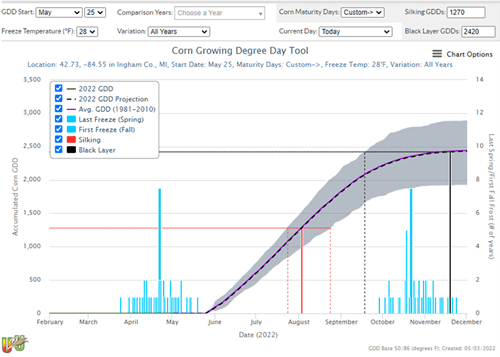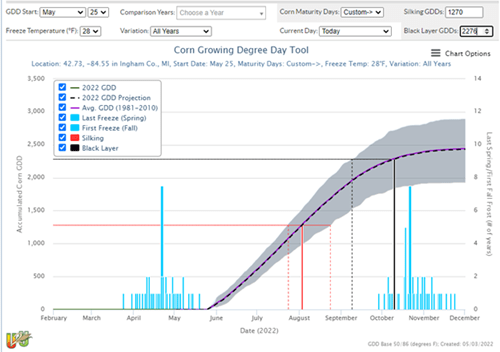Spring Planting Order; Delayed Planting and GDU Compression; Black Cutworm
BY DAIRYLAND SEED AGRONOMY TEAM
SPRING PLANTING ORDER
As Spring 2022 or #plant22 for those of you who follow social media, progresses, it appears that most of the Dairyland Seed geography will have areas where very little seed, both corn and soybeans have been planted. This is in comparison to some planting seasons where a large area of our geography has both crops planted by this time.
When the weather clears and soil conditions improve, for most producers the thought will be we need to plant corn and to get that in before soybeans are planted. Recent articles and studies have provided great documentation and insight as to the advantages of planting soybeans prior to corn. I will not enter into that discussion at this time, I would however point out that with the compressed planting season it appears many will have, that being flexible, and planting the intended crop on whichever fields are suitable to go first, would be the wise business decision to make.
That decision to switch it up and plant one crop before the other due to field conditions may involve communicating that decision to your family and employees as well as your Dairyland Seed Dealer and District Sales Manager. Being able to switch the planter from one crop to the other and back again may take some time, however it may help get the intended crop into the ground sooner compared to later.
Lastly, and this is with any activities on your operation, but especially when we are working longer hours, let’s take a moment and remember to do that job safely. Not only are you setting an example of doing a task the safe way, for your family, and employees but also community members.
DELAYED PLANTING AND GROWING DEGREE UNIT COMPRESSION
The extended cool and wet weather has kept many of us out of the fields and has raised concerns about planting delays. A common question among growers is whether they should consider switching some of their full-season hybrids to shorter-maturity hybrids, and if so, how soon? The short answer to that question is no, it’s still way too early to consider switching hybrids. Although delayed planting shortens the growing season, the main driver is still growing degree units (GDUs) for the plant to reach physiological maturity before a killing frost.
GDUs, also called growing degree days (GDD) and heat units (HU), are the calculated accumulation of heat on a daily basis. The corn plant is very dependent on temperature to move through its growth stages. The warmer the temperature (to a max of 86°F) the faster a corn plant develops. An interesting observation over the past several years is that late planted corn hybrids are requiring less GDUs to reach maturity. Research conducted by Dr. Nielsen at Purdue and Dr. Thominson at Ohio State showed that corn can undergo compression during the reproductive stages to help reach physiological maturity (black layer). This means that a later planted corn plant is able to “make up ground” and reach black layer with significantly less GDUs.
GDU Compression
Dr. Nielsen at Purdue found that hybrids planted after May 1st and through the second week in June matured with 6.8 GDUs less per day. If a hybrid that required 2500 GDUs to reach maturity was planted on May 31st it would only require about 2300 GDUs to reach black layer. Research out of Michigan State indicates an average of 5.6 GDUs less per day after May 1st. The range of compression at Michigan State was 4.0 GDUs with 89 RM hybrids up to 7.4 GDUs with 109 RM hybrids, showing more compression with full-season hybrids. This gives us a benefit against switching maturities.
Useful to Usable Tool
The Useful to Usable (U2U) tool is a multi-state tool that uses current and historical climate data to help predict when your corn will reach certain growth stages including physiological maturity. This tool can be found at https://mygeohub.org/groups/u2u/purdue_gdd. Start by entering your location then enter the planting date of interest. Next you can manually enter the GDUs to silking and to maturity which can be found on the product tech sheets. Figure 1 shows an example of DS-4510Q™ planted on May 25th in Lansing, MI. The gray shaded region shows the highest and lowest expected GDU accumulation for the rest of the season. Anticipated silking date is represented by the red vertical line and the black vertical line represents the expected black layer date. The dashed black line indicates the first likely black layer date. The tall dark blue bar represents the probability of the first 28-degree night.

Figure 1. U2U example using DS-4510Q™
In the Figure 1 example, DS-4510Q™ is not predicted to reach black layer before the first 28-degree frost. One problem with this model is it does not take GDU compression into consideration. If we figure 6 less GDUs for each day after May 1st (6 GDUs x 24 days = 144 GDUs less) then we would reduce the GDUs required to reach black layer by 144 units, making our black layer GDD number 2276. Figure 2 shows the same scenario with GDU compression and DS-4510Q™ is expected to reach black layer about 12 days before a killing freeze. Even if we delay the planting date to May 31st and account for the GDU compression, DS-4510Q™ is still expected to reach black layer a week before the most likely lethal freeze.

Figure 2. U2U example using DS-4510Q™ considering GDU Compression
Remember this is just a projection of the most likely scenario but still gives you a very useful guide for your area. Although planting is delayed a little from previous years, we still have a lot of time to get seed in the ground. Another key point to keep in mind is planting into marginal soil conditions can reduce yield more than late planting. If you have any questions, feel free to reach out to your Dairyland Seed DSM or Regional Agronomist.
BLACK CUTWORM
Black Cutworm pheromone trap reports have shown an increase in moths over the last week. Black cutworms overwinter in Mexico and Texas and are delivered to us through storm systems that originate in those areas. These same storm systems have made field work this spring difficult and, in some cases, nonexistent allowing winter annual plants to continue to grow and create a favorable environment for the moths to lay eggs.
Identification:

Mark Dreiling, Bugwood.org
Black cutworm moth is identified by the dagger shaped marking on the forewing, which is circled in the picture.

Roger Schmidt, University of Wisconsin Madison, Bugwood.org
Black cutworm larvae are dark in color and can be found under soil clods, debris or 1-2 inches below the soil surface. These larvae can be 1/8th inch to 2 inches in length. Black cutworm moth is identified by the dagger shaped marking on the forewing, which is circled in the picture.
Areas to monitor: No-till and reduced tillage fields, especially those with dense vegetation of broadleaf weeds.
Scouting: Damage can appear as notched leaves which is done by younger larva and clipped plants that will have been cut at the soil surface. When assessing this damage choose 5 random areas of the field and count 20 plants in those areas. If 3-5% of these plants show signs of black cutworm feeding and 2 cutworms can be found, control with an insecticide may be warranted.

Damage from a small cutworm.

Clemson University - USDA Cooperative Extension Slide Series , Bugwood.org
Damage from a more mature cutworm larvae, note the “clipped” plant at the soil surface.
Weedy areas of a field are the main areas to be concerned with at this time. When corn planting begins again and herbicide applications start to diminish the current food source for the cutworm larvae, we could start to see feeding in our corn plants. All versions of the Optimum® AcreMax® hybrids and Qrome®, and SmartStax® can provide control to smaller larvae but larger larvae may still warrant further control measures.
Contact your Dairyland Seed DSM or Regional Agronomist for more information.
 |
 |
 |
 |
 |
| Brian Weller Western Region 507.456.3034 |
Dan Ritter Central Region 219.863.0583 |
Branden Furseth Northern Region 608.513.4265 |
Mark Gibson Eastern Region 260.330.8968 |
Amanda Goffnett Eastern Region 989.400.3793 |
